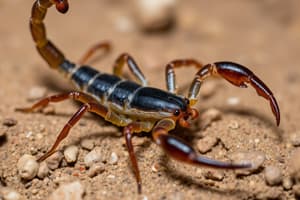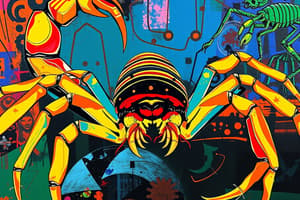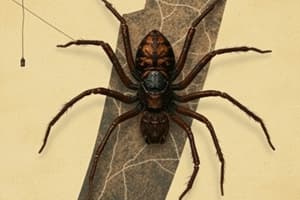Podcast
Questions and Answers
What are the two tagmata found in all arachnids, and what does each primarily contain?
What are the two tagmata found in all arachnids, and what does each primarily contain?
The two tagmata are the cephalothorax (head and thorax) and the abdomen. The abdomen houses the reproductive and respiratory organs, while the cephalothorax bears chelicerae, pedipalps, and walking legs.
Describe how spiders utilize digestive enzymes in their feeding process.
Describe how spiders utilize digestive enzymes in their feeding process.
Spiders release digestive enzymes over or into their prey to predigest the tissues, then they suck the resulting liquid into their stomachs.
Explain the purpose of the fine setae on a spider's legs, especially considering their vision is often poor.
Explain the purpose of the fine setae on a spider's legs, especially considering their vision is often poor.
The fine setae on a spider's legs detect vibrations in the web, struggling prey, or even air movements, providing awareness of the environment where their vision may be limited.
How do spiders liquefy their prey before consumption?
How do spiders liquefy their prey before consumption?
Describe the two genera of spiders in the United States known for causing severe or even fatal bites.
Describe the two genera of spiders in the United States known for causing severe or even fatal bites.
What is the primary function of the compound slit sensilla located on the last segment of a sand-dwelling scorpion's legs?
What is the primary function of the compound slit sensilla located on the last segment of a sand-dwelling scorpion's legs?
What purpose do the comb-like pectines serve on the ventral side of a scorpion's abdomen?
What purpose do the comb-like pectines serve on the ventral side of a scorpion's abdomen?
Explain how ticks and mites differ from other arachnids regarding the fusion of their cephalothorax and abdomen.
Explain how ticks and mites differ from other arachnids regarding the fusion of their cephalothorax and abdomen.
Describe the function of the capitulum in acarines.
Describe the function of the capitulum in acarines.
What is the role of silk glands in spider mites (family Tetranychidae) and how does this affect plants?
What is the role of silk glands in spider mites (family Tetranychidae) and how does this affect plants?
How do centipedes subdue and consume their prey?
How do centipedes subdue and consume their prey?
Describe two methods by which millipedes protect themselves from predation.
Describe two methods by which millipedes protect themselves from predation.
How do arachnids that use silk to capture prey subdue their targets?
How do arachnids that use silk to capture prey subdue their targets?
What specialized respiratory structures do spiders possess, and how do they function?
What specialized respiratory structures do spiders possess, and how do they function?
Explain the distinctions between neurotoxic and haemolytic venom, mentioning which spider in the United States produces each.
Explain the distinctions between neurotoxic and haemolytic venom, mentioning which spider in the United States produces each.
What is unique about how acarines carry their mouthparts compared to other arachnids?
What is unique about how acarines carry their mouthparts compared to other arachnids?
How does the diet of millipedes typically differ from that of centipedes?
How does the diet of millipedes typically differ from that of centipedes?
Describe the process by which spiders spin silk, including the structures involved and the unique properties of spider silk.
Describe the process by which spiders spin silk, including the structures involved and the unique properties of spider silk.
What role does silk play in the lives of spiders that do not spin webs for trapping prey?
What role does silk play in the lives of spiders that do not spin webs for trapping prey?
How can you differentiate between centipedes and millipedes based on their physical characteristics and behavior?
How can you differentiate between centipedes and millipedes based on their physical characteristics and behavior?
Flashcards
Phylum Arthropoda
Phylum Arthropoda
Arthropods are segmented invertebrates with exoskeletons.
Subphylum Chelicerata
Subphylum Chelicerata
A subphylum of arthropods characterized by having chelicerae.
Class Arachnida
Class Arachnida
A class of chelicerate arthropods including spiders, scorpions, mites, and ticks.
Arachnid Tagmata
Arachnid Tagmata
Signup and view all the flashcards
Order Araneae
Order Araneae
Signup and view all the flashcards
Pedicel (in Spiders)
Pedicel (in Spiders)
Signup and view all the flashcards
Chelicerae in Spiders
Chelicerae in Spiders
Signup and view all the flashcards
Pedipalps in Spiders
Pedipalps in Spiders
Signup and view all the flashcards
Book Lungs
Book Lungs
Signup and view all the flashcards
Tracheae
Tracheae
Signup and view all the flashcards
Setae
Setae
Signup and view all the flashcards
Spinning Glands
Spinning Glands
Signup and view all the flashcards
Order Scorpiones
Order Scorpiones
Signup and view all the flashcards
Chelate Pedipalps
Chelate Pedipalps
Signup and view all the flashcards
Pectines
Pectines
Signup and view all the flashcards
Subphylum Myriapoda
Subphylum Myriapoda
Signup and view all the flashcards
Class Chilopoda
Class Chilopoda
Signup and view all the flashcards
Venom Claws
Venom Claws
Signup and view all the flashcards
Class Diplopoda
Class Diplopoda
Signup and view all the flashcards
Repugnatorial Glands
Repugnatorial Glands
Signup and view all the flashcards
Study Notes
Arthropoda
- Classified into subphyla: Trilobita, Chelicerata, and Myriapoda
- The class Arachnida includes scorpions, spiders, mites, ticks, harvestmen, and pseudoscorpions, exhibiting significant anatomical diversity.
- Diverse taxa vary significantly in form and appendages.
- Most arachnids are free-living, thriving in warm, arid climates, with over 80,000 species described and are among the first arthropods to colonize terrestrial habitats.
Arachnid Anatomy
- Possess two tagmata: a cephalothorax (head and thorax) and an abdomen (segmented or unsegmented).
- The abdomen houses reproductive and respiratory organs like tracheae and book lungs.
- The cephalothorax has a pair of chelicerae, pedipalps, and four pairs of walking legs.
- Most are predaceous with fangs, claws, stingers, or venom glands; fangs from modified chelicerae and claws from pedipalps.
- Typically possess a powerful sucking pharynx to ingest fluids and soft tissues from prey.
- Spiders have spinning glands as a unique adaptation.
Arachnid Interaction with Humans
- The majority are harmless to humans, aiding in the control of harmful insects.
- Arachnids digest prey by secreting digestive enzymes and then consuming the pre-digested liquid.
- Black widow and brown recluse spiders are exceptions, possessing dangerous bites
- Scorpion stings are painful, and certain species can inflict fatal stings.
- Disease vectors: ticks and mites, while others cause irritation and damage to plants.
Order Araneae: Spiders
- Large arachnid group of around 40,000 species worldwide
- They possess a compact body with a cephalothorax (prosoma) and an abdomen (opisthosoma) which are unsegmented
- Body joined by a slender pedicel
- Segmented abdomens found in some spiders are considered ancestral
- They have anterior appendages with chelicerae, venom ducts, and leg-like pedipalps with sensory functions
Spider Anatomy and Feeding
- Pedipalp bases can manipulate food
- Four pairs of legs terminating in claws for locomotion
Spider Hunting
- All spiders are predators that primarily kill insects through venom injection
- Some spiders hunt, some ambush, and some ensnare prey using silk nets
- Venom liquefies prey tissues, which are then ingested
- Some spiders chew prey with teeth-like structures on chelicerae, enhancing digestion
Spider Respiration And Sensory
- Gas exchange occurs through book lungs, tracheae, or both
- Book lungs comprised of air pockets that extend into a blood-filled chamber
- Tracheae formed of air tubes that carry air from a spiracle
- Eight simple eyes with lenses, retinas, and optic rods perceive motion (hunting spiders can form images)
Spider Adaptations
- Depend on the fine setae on their legs to detect vibrations due to poor vision
- Web-spinning is a key adaptation
- Spinnerets connect to abdominal silk glands and secrete a scleroprotein
- Spinnerets produce silk stronger than steel and second only to fused quartz fibers
Spider Webs and Diversity
- Diverse silk webs range from simple strands to geometrical orb webs
- Spiders use silk for nest lining, egg sacs, bridge lines, draglines, warning and molting threads, attachment discs, and prey wrapping
- Wolf spiders, jumping spiders, and fisher spiders chase prey and have lost the ability to produce silk
Spider Venom and Interactions With Humans
- Spiders are timid creatures that are allies in controlling insects, not dangerous enemies
- Venom produced is usually harmless to humans
- The most poisonous spiders only bite when threatened
- American tarantulas are not dangerous
- Two genera with severe bites: Latrodectus (black widow, five species) and Loxosceles (brown recluse, 13 species)
- Black widows identified by red hourglass marking, contain neurotoxic venom, potentially fatal
- Brown recluse spiders identified by the violin-shaped stripe, contain haemolytic venom, mildly to seriously toxic
- Dangerous Spiders: Atrax spp. (funnel web spiders in Australia) and Phoneutria genus (South and Central America)
Order Scorpiones: Scorpions
- Ancient terrestrial arthropods, totaling around 1400 species globally
- Most commonly found in tropical and subtropical regions, some in temperate zones
- Generally secretive, hiding during the day and hunting at night
- Sense prey with compound slit sensilla on their legs
Scorpion Anatomy and Feeding
- Predatory arthropods primarily feed on insects and spiders
- Seize prey with pedipalps and shred with chelicerae
- Can locate prey 50 cm away and catch it in three or four quick movements
- Scorpion tagmata: a short cephalothorax (used for sensory) and a pre-abdomen (mesosoma) and post-abdomen (metasoma) which ends in a stinger
Scorpion Distinguishing Features
- Posses chelicerae, pedipalps, and eight-jointed walking legs
- Ventral comb-like pectines are tactile organs used for sex recognition and exploring the ground
- The stinger on the last segment is a bulbous base and a curved barb that injects venom
Order Acari: Ticks and Mites
- Most economically and medically important arachnid group
- Larger than other orders in species and individuals
- Estimated 500,000 to 1 million species
- Live in terrestrial and aquatic habitats: deserts, polar regions, and hot springs
- Most mites are parasitic for at least one stage
Acari Anatomy
- Small, 1 mm or less, except for ticks
- Ticks can expand to 3 cm
- Cephalothorax and abdomen completely fused with no segmentation
- Mouthparts on a capitulum
- Chelicerae function in piercing or tearing food
- Segmented pedipalps lateral to chelicerae
Acari Reproduction
- Adults usually have four pairs of legs, in specialized forms, there are only one to three
- Most transfer sperm directly or use a spermatophore
- Larvae have six legs, succeeding nymphal stages have eight legs
- Dermatophagoides farinae and related species are found in house dust and cause allergies and dermatoses
Acari Ecology
- Most aquatic mites live in freshwater and have hairlike setae and parasitic larvae
- Ecologically important, they can affect food supply and health
- Spider mites (family Tetranychidae) are serious agricultural pests that damage plants
- These mites extract plant cells through webs from silk glands
Class Chilopoda: Centipedes
- Land arthropods with flattened bodies, in moist environments like logs, stones and bark
- Agile carnivores feeding on insects and earthworms
- They use venom claws to kill prey, mandibles to chew
- Scolopendra gigantea is the largest centipede at 30 cm
- Common house centipedes Scutigera contains 15 pairs of legs, catching other insects
Centipedes: Harmlessness
- Most centipedes are harmless: tropical species are dangerous
- Centipede bodies can contain segments from a few to 177
- Each segment has jointed legs except the head and the last two segments
Centipede Anatomical Features
- Appendages of the first segment form venomous claws
- The last pair of legs used for sensory functions are longer than others
- Head appendages: antennae, mandibles, and maxillae, similar to insects
- A pair of eyes on the dorsal side of the head consists of groups of ocelli.
- Digestive is a straight tube empty salivary glands empty at the anterior
- Two pairs of Malpighian tubules are located into the hind part of the intestine
Centipede Body Systems
- Elongated heart with arteries and ostia
- A pair of spiracles in each segment for tracheal system respiration
- Nervous system is arthropodan with a visceral nervous system
- Sexes are separate, with unpaired gonads and paired ducts
- Centipedes lay eggs (oviparous) or bear live young (viviparous), undergo no metamorphosis
Class Diplopoda: Millipedes
- Commonly known as millipedes meaning "thousand feet"
- Inactivity compared to centipedes, walking gracefully
- Prefer dark, moist places such as under logs or stones
- Herbivorous feeding on decayed plant matter
- Millipedes are slow and roll into a coil when disturbed
- They can secrete toxic chemicals as a predation defense mechanism from repugnatorial glands
Millipede Diversity
- Spirobolus and Julus: examples with wide distribution
- There are more than 10,000 species of millipedes worldwide
- The cylindrical body with 25 to more than 100 segments
- Four segments located in the short thorax all bearing one pair of legs
Millipede Anatomy
- Each abdominal segment has two pairs of legs
- Exoskeleton is reinforced with calcium carbonate
- Head anatomy: two clumps of simple eyes, antennae, mandibles, and maxillae; similar to centipedes
- Each abdominal segment contains two pairs of spiracles that connect to tracheal air tubes leading to air chambers
- Appendages of the seventh segment are specialized as copulatory organs
Millipede Reproduction
- Millipedes guard their lays after copulation
- Larval forms have only one pair of legs to each segment.
Phylum Arthropoda: Subphylum Crustacea
- Includes the classes of Crustacea
- Class Malacostraca
- Class Maxillopoda
- Subclass Copepoda
Class Malacostraca
- Largest class of Crustacea (over 20,000 species), exhibiting great diversity
- Classified into subclasses, orders, suborders, infraorders, and superfamilies
- Eight segments located in the thorax and six plus telson in the abdomen
- All segments with appendages, biramous antennules and first thoracic appendages like maxillipeds
- Carapace covers head and part or all of thorax, sometimes absent
- Gills usually thoracic epipods
Malacostraca: Order Decapoda
- Decapoda: shrimps, crabs, lobsters
- Features: thoracic segments fused from carapace; eyes on stalks; the first three pairs of thoracic appendages modified to maxillipeds; five pairs of walking legs
- In crabs: first pair of legs modified to pincers (chelae)
- Size range between millimetres to four metres
- Commercially relevant decapods include crayfishes, lobsters, crabs, and shrimp
Class Maxillopoda
- Contains a number of crustacean groups traditionally considered classes
- They have five cephalic, six thoracic, and usually four abdominal segments plus a telson, reductions common
- No appendages on either the abdomen; an eye is the nauplius
Maxillopoda: Subclass Copepoda
- This group is third only to Malacostraca with billions of tons and species
- Copepods are small (usually a few millimeters or less in length), elongated tapering at the posterior
- Without a carapace with a nauplius eye
- Have a pair of uniramous maxillipeds and flattened thoracic swimming appendages
- Possessed a major articulation on appendage-bearing portion where antennules are employed
- A great number a species diverse in both freeloading and freeliving
- Many parasites so highly modified
Copepod Ecology
- Copepods are have a major contribution at the primary consumer level in aquatic communities
- Highly populated in zooplankton, with a greater proportion of total biomass
- Calanus important dietary component of economically and ecologically fish like herring and sardines for sharks and whales
- Common in various marine invertebrates, economically important
- Copepods serve as hosts for tapeworms and nematodes which show morphoses
Arthropoda: Subphylum Hexapoda: Class Entognatha
- Encompasses entognaths where the base of jawlies within the head
- Features one
- Entomobrya: example species
- Proturans have a minute (1 to 1. 5 mm)
- This species lacks an antennae and lives in humid places in soil
- Diplurids are japygids and campodeids
- This species is eyeless and found in logs
- Collembollanous are jumping eye patches
Hexapoda: Class Insecta
- Insects: in-sekta with two mandibular regions
- Drosophila, Bombus, and Anopheles
- Subclass Apterygota: primitive with no wings
- Thysanura: silverfish and bristletails with long antennae
Pterygota
- This species lives around stones from the around the surrounding environment
- Condition if winged
Pterygota: Paleoptera
- Ephemeroptera features -membranous wings the aquatic -with wings with lateral tracheas
- Lacks odoanta lacks a gill containing labium to acquire food -Dragonflies are nets that long the body
Arthropoda: Neoptera
- Orthoptera: Locust and grasshoppers that fold
- Blattode: Tropicals known as segments are known to exceed houses
- Phasmatodea: herbivore with expanded forms to be long
Factors Contributing to the Biological Success of Arthropods
- Versatile Exoskeleton: strong without preventing mobility
- The cuticle skeleton: layers that secret underlying epidermis -Procuticles are thick and epicuticles are thin with layers -Protein are stabilized with waxes that limit heat loss -Procuticles are secreted and the exocuticles are layered with Chitin, which is a flexible polysaccharide
Segmentation and Appendages contributing to Arthropoda
- Ancestral body plans for appendages that create a wide range
- Combination of segments with tagamata
- Functional groups that contain legs and striated muscles that provide action
- Sensory hairs are also in walking and swimming
Internal Systems
- Air is piped to cells through tubes, aquatic environments are breathable through gills
- Highly developed organs aid in touch-sensitive areas
- Complex behaviour patterns: innate learning controls aspects of activities
- Limiting Intraspecific Competition through Metamorphosis change their structure
Studying That Suits You
Use AI to generate personalized quizzes and flashcards to suit your learning preferences.




